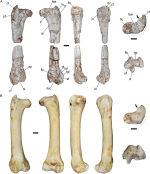Systematic palaeontology
Class Aves Linnaeus, 1758
Subclass Neognathae Pycraft, 1900
Order Cathartiformes Coues, 1884
Family Cathartidae Lafresnaye, 1839
Genus
Vultur Linnaeus, 1758
Type species
Vultur gryphus Linnaeus, 1758
Included species
Type species and
V. messii sp. nov.
Vultur messii sp. nov.
Diagnosis
MCH 363 is assigned to genus Vultur (a genus that until the discovery of the new material was monotypic) based on the presence of a single foramen and a marked protuberance located medially to the crista trochanteris, an impressio lig. cruciati cranialis widely extended and a condylus lateralis that gradually transitions towards the diaphysis. It differs from
Vultur gryphus in the following features: the presence of a much larger unique foramen, a caudal deep pit bounded cranially by the narrower facies articularis antitrochanterica, a markedly medially deflected crista trochanteris, a rounded and markedly large scar of origin of the m. gastrocnemius pars intermedia, an impressio ansae m. iliofibularis facing caudally, and a wide and shallow sulcus patellaris.
Holotype
MCH 363, right femur lacking part of the diaphysis.
Etymology
Honouring the Argentinean football player Lionel Andrés Messi, one of the best of our times, who, being captain and best player, together with an outstanding team won the FIFA World Cup in Qatar 2022.
Procedence
Andalhuala Formation (Late Miocene-Early Pliocene). S27°17’34.2’ W66°54’40.4’, San Fernando Norte, Belén Department, Catamarca province. The fossil comes from older deposits than 4.8 Ma, corresponding to the Early Pliocene.
Description
The caput femoris is stout, slightly constricted (not constricted in
Vultur and
Cathartes) with a marked and deep fovea lig. capitis. As in
Vultur, the facies articularis acetabularis is poorly extended distally (not extended in
Cathartes and
Coragyps). The facies articularis antitrochanterica is narrow, bounding caudally a deep pit, absent in other cathartics (in
Gymnogyps there is a long furrow, endowed with pneumatic foramina, laterally bounded by a marked, caudally directed tubercle absent in
Vultur). Medial to the stout crista trochanteris (stouter in
Gymnogyps), a large pneumatic foramen is placed (as is typical of Cathartidae). Having a unique foramen is also observed in
Vultur gryphus,
Breagyps clarki and
Gymnogyps californianus, however this opening is much larger in the fossil species, and similar to
Geronogyps and
Breagyps. However, in
Breagyps, the foramen is more proximally located, while in
Geronogyps is more distally located, and in
Gymnogyps, there is a deep furrow proximal to the foramen. Medially to this foramen, there is a marked curved ridge that bounds the foramen. This ridge is straighter in
Vultur,
Coragyps, and
Cathartes. When viewed proximally, medially to the crista trochanteris, a marked protuberance is located, a feature observed only in
Vultur among cathartids (this protuberance, although present is much less developed and barely noticeable in
Gymnogyps). The crista trochanteris is markedly bended medially, similar to
Breagyps and
Geronogyps. The caudal angle between the lateral margin of the crista trochanteris and the caudal aspect of the facies articularis antitrochanterica is obtuse, and larger than that of
Vultur (much smaller, and acute in
Cathartes). The scar for the insertion of the m. iliotrochanteris caudalis is narrow and poorly marked (contrary to
Vultur). The impressio obturatoriae has a marked oval shape. The scar of the insertion of the m. iliofemoralis internus has an oval shape, very similar to that of
Vultur. The linea intermuscularis cranialis is poorly marked.
The distal area of the femur is more badly preserved, heavily crushed and lacking a portion of the condylus medialis. The fossa poplitea is deep and wide (shallow in
Coragyps and
Gymnogyps), with at least two noticeable large pneumatic foramina. This fossa is bounded laterally by the condylus lateralis, which when viewed laterally has a gradual transition towards the diaphysis as in
Vultur (abrupt transition in
Coragyps and
Cathartes). The scar of origin of the m. gastrocnemius pars intermedia is rounded and large (smaller and oval in
Vultur). The impression lig. cruciati cranialis is very wide and extended, as in
Vultur (shallow and narrow in the smaller
Cathartes and
Coragyps). The tuberculum m. gastrocnemialis lateralis is low, large, with a heartshaped scar (oval in
Vultur, rounded in
Coragyps and
Cathartes). The impressio ansae m. iliofibularis is small and oval, distally located in the aforementioned tuberculum, and faces caudally (caudolaterally in
V. gryphus, laterally in
Geronogyps and
Breagyps). As in
Vultur, the linea intermuscularis caudalis extends distally laterally on the shaft, bounding a scar located right proximally over the crista lateralis sulci patellaris (laterally located in
Cathartes and
Coragyps). This crista is stout and wide, bounding laterally a wide but shallow sulcus patellaris (narrow in
Geronogyps and deeper in
Vultur gryphus, in
Gymnogyps it is wide and deep, and present a quadrangular contour when viewed distally). The impressio lig. collateralis lateralis is shallow. The fovea tendinis m. tibialis cranialis is shallow as in
Cathartes (deep in Vultur). The sulcus intercondylaris is shallow (deep in
Gymnogyps).
Fred
Figure 1. Holotype of
Vultur messii sp. nov., MCH 363, right femur (A), compared with that of
Vultur gryphus CIT-O 263 (B) in cranial, caudal, lateral, medial, proximal and distal views. Abbreviations: cl, condylus lateralis; ct, condylus medialis; faa, facies articularis antitrochanterica; flc, fovea lig. capitis; fp, fossa poplitea; ftc, fovea
tendinis m. tibialis cranialis; gi, scar of m. gastrocnemius pars intermedia; ial, impressio ansae m. iliofibularis; icl, impressio lig. collateralis lateralis; ifi, scar of m. iliofemoralis internus; ilcc, impressio lig. cruciatum cranialis; io, impressio obturatoriae; itc, scar of m. iliotrochanteris caudalis; p, caudal pit; pf, pneumatic foramen; sf, sulcus fibularis; si, sulcus intercondylaris; sp, sulcus patellaris; tf, trochanter femoris; tgl, tuberculum m. gastrocnemius lateralis. The black arrow points at the characteristic medial protuberance of
Vultur.
Scale = 1 cm.`.







